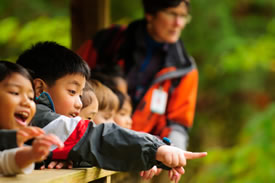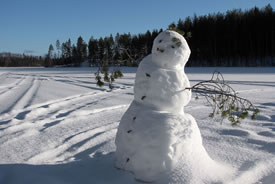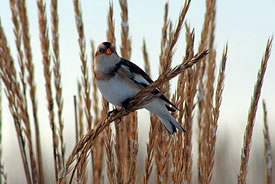Five ways to incorporate nature into your March Break

Students from John Norquay Public School, Nature Days Vancouver (Photo by HSBC Bank Canada)
While March is one of the months without a long weekend, many families are looking for ways to spend time together as students take leave for a week-long winter break. With the deep freeze finally behind us and balmier temperatures triggering a natural instinct to get active, here are five simple ways to spring into the season with your family and loved ones:

Snowman on frozen lake (Photo by Peritap, Wikimedia Commons)
Savour the last of your winter activities
There are only certain things we can enjoy during winter with the bonus of peace from the mosquitoes and insects. As snow turns into slush and the ground slowly thaws, natural areas accessible by snowshoes and cross-country skis can soon be muddled with puddles. Grasp the chance to take a quiet walk through the woods while you can! Be on the lookout for animal tracks, the distant chatter of a winter bird, camouflaging wildlife or even animal scat.
Gear up for spring
Some springtime activities are better enjoyed when you are properly equipped (e.g. a good pair of binoculars or an ergonomic hiking backpack). Do some research to learn about how to properly outfit yourself for your next outdoor adventure. Even if you’re window shopping, many local shop owners are generous with advice and pointers on how you can enhance your time in nature.
Catch the last of the winter birds

Snow bunting (Photo by Wikimedia Commons, John Haslam)
Snow buntings, snowy owls, snow... need I say more? Despite our gravitation towards a warmer south during the bitter cold winter, there are lots of feathery friends that make southern Canada their winter destination. It won’t be long until these seasonal visitors depart for their northern homes and now is the perfect time to catch a glimpse of them until next winter! Give them a nutritious send-off gift by making a pine cone bird feeder. Simply spread peanut butter on the surface and crevices of the pine cone, roll it in bird seed and hang it up on a tree.
Make a field journal
A small, pocket-sized notebook is all you need. Get into the practice of recording neat observations each time you head out. Scientists need field journals to record their work. But often times, researchers also rely on citizen scientists to help contribute observations that can lead to eureka moments — like the endangered blue-grey taildropper discovery made by a seven-year-old boy during a visit to Chase Woods, a Nature Conservancy of Canada property in British Columbia.
DIY wildlife postcards

Carl Zeiss sonnar lens (Photo by Mohylek, Wikimedia Commons)
Planning to head out of town? This can be a great opportunity to learn about wildlife away from home. Take the chance to snap photos of these wild encounters and share them on social media. If possible, print and create your personalized non-touristy postcards and snail mail them to family and friends back home!
So? Go wild this spring and explore outdoor nature play with your family keeping in mind the golden rule when spending time in nature: “leave nothing but footprints and take nothing but pictures.”


